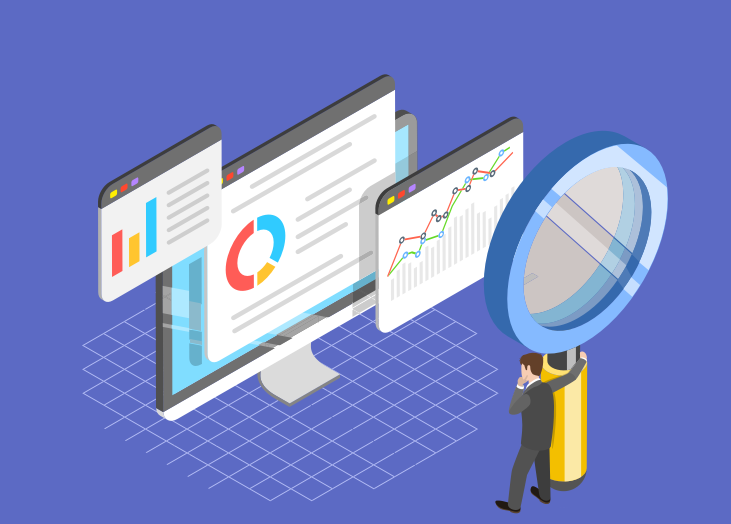You might be utilizing all the features that BrightGauge offers - dashboards, reports, and goals (if you are, that’s awesome). But some of our customers have expressed confusion over the best way to ...
You might be utilizing all the features that BrightGauge offers - dashboards, reports, and goals (if you are, that’s awesome). But some of our customers have expressed confusion over the best way to overlap some of our features. That’s what we’re here for. We want to give you some tips and tricks that’ll help you get the most out of your data and your use of BrightGauge. After all, what good is your data if you can’t use it to make a positive impact on your business? Today, we’ll discuss how you can use a gauge feature - thresholds - to help you track your goals. Thresholds ensure that nothing falls through the cracks If your team is responsible for time-sensitive tasks, then you can’t afford to skimp out on thresholds. They work by alerting you in real-time to threats that need attention. They take just a moment to set up within your gauge. When you’re in your gauge builder, simply click on the Design module on the left-hand side of your page and customize your threshold according to your preferences. What you consider urgent may differ from that of your peers, so it’s completely up to you to choose when you’d like to be alerted because you know what works best for your team and your company. Tying thresholds to goals We talk a lot about the importance of setting goals and we’ll probably never let that conversation go (sorry, not sorry). When it comes to goals, the 3 best practices we’re always reinforcing are: - tie goals to overall company KPIs - make sure you’re setting SMART goals - don’t tie goals to performance reviews Since BrightGauge helps you see all your important KPIs whenever you want to, you’re already well on your way to creating goals that complement those KPIs. Once you’ve set those goals, take your KPI display one step further by using thresholds to help you track goal performance. For example, if you’re using an RMM like ConnectWise Automate to stay on top of your machine statistics, you’re going to want to know how many servers you have offline at any given time. If you set up a custom threshold to monitor that data, an alarm will sound and your gauge will change colors as soon as there’s an issue that requires your attention. Or you might be using ConnectWise Manage or another PSA to get a handle on your tickets. Like most service leaders, you probably care a whole lot about your team’s ticket response time. To make sure you are never reaching a point of “disaster”, you could set up 3 threshold alerts within the same gauge: 1) the cell turns green if your number is equal to 30 minutes (this is your ideal number); 2) the cell turns yellow if your number is greater than 60 minutes (this is a warning); 3) the cell turns red and a bell sounds if your number is greater than 120 minutes (this is an urgent issue that needs your attention!) Note: currently, thresholds can only be set for number and text fields. Most gauge types support both fields, but Number and Progress gauges support only number fields and Pie Charts support only text fields. Read more about gauge thresholds here. Now that you know what goals you want to track and you’ve set thresholds to make sure you’re hitting your target, make sure you keep things visible! Put your threshold gauges up on a dashboard that you visit frequently. By doing this, you’ve got tabs on your crucial data and on your goal progress all day, every day. That’s how you tie it all together. For more on goals, check out this podcast with our CEO, Brian Dosal, as he discusses why goals are necessary for any thriving business: The Importance of Goal-Setting.

At a recent Data Driven Workshop, one of our customers raised her hand and asked, “Is it possible to ‘favorite’ a filter when building gauges?”. There is actually a way to do this, but we refer to it as saving linked filters, and it could save you a boatload of time if you’ve got a lot of gauges to build. It’s really simple to do and we’ll walk you through it. How to set up linked filters Linked filters allow you to edit and apply the same filter across multiple gauges. If you’ve ever spent a day or even a couple of hours building gauges, then you can imagine how valuable this feature is. There are just a few quick steps involved in setting this up: 1. Build your gauge From your BrightGauge overview page, click on the green plus sign in the top nav and select ‘Gauge’ from the dropdown menu. Choose the datasource and dataset you’d like to build the gauge from and start populating your fields. By the way, if you’ve got an existing gauge you want to add a filter to, just click on ‘GAUGES’ in the top nav of your BrightGauge overview page to access all the gauges in your account. 2. Add a filter The beauty of BrightGauge is that you can add filters to your gauges so that you get the exact, specific data you’re looking for. You can filter by text, date, number, and boolean fields. So, for example, if you’re interested in positive CSAT reactions for a particular technician (say, Hector), build that gauge and then create a filter for the individual you have in mind. 3. Create a linked filter Maybe you want to monitor Hector’s performance across the board, but you might have 50 different gauges that you could filter for Hector. That would take a heck of a long time to work through. Instead, link it! In the filter pill in your gauge, you’ll notice a little plus sign. Click on that guy. A window will pop up that will prompt you to name your filter (i.e., Hector) and select which gauges or gauge layers within that dataset you want to apply that filter to. As soon as you hit ‘Create Filter’, that linked filter will be added to all the gauges you chose! The pill will change from green to blue so you can easily identify which of your filters are linked, no matter which gauge you’re in. Once the linked filter is created, you’ll be able to add it to any new gauge or gauge layer within that datasest. If you ever edit that filter, it will edit across all gauges it is applied to. Pretty cool, right? Linked filters rules to remember Like most things that are fun and useful in life, linked filters come with a set of rules. Don’t worry, it’s nothing too crazy, we just want you to make the most of this feature. 1. First things first: when you create a gauge with a filter that you want to turn into a linked filter, save the gauge! 2. Are you creating a new gauge and you’ve come to the realization that the value of your linked filter should change across all gauges? Make sure you save the new gauge first, otherwise your value change won’t be applied to other gauges using that linked filter. 3. Did you accidentally delete your linked filter from a gauge? No worries! Click the green plus sign in the Filters field of your gauge value to re-add it. 4. You can delete a linked filter from the edit modal. This would remove the filter from all the gauges it is on. 5. The most important rule of all: if you need any help whatsoever, don’t be afraid to ask! Visit our support page or submit a support ticket. Curious how your service team stacks up against the rest? Take our Service Readiness grader to get your team score, find out what KPIs you should be tracking, and more.

When it comes to BrightGauge best practices, we often find it really valuable to turn to our peers for support. Seeing how others are using BrightGauge dashboards and reports helps us understand their capabilities in different ways or see benefits we may have missed on our own. After all, sharing is caring, right? Or did our moms just tell us that to get us to play nice? Anyway, we digress. Recently, we’ve been asking some of our customers how they are using BrightGauge to keep their employees motivated, and we’ve heard lots of creative solutions! One that came up repeatedly was the idea of using dashboards to create some friendly competition. We’ve talked about this in the past and it’s cool that this tactic is working for so many people out there. In the spirit of sharing, we’re talking different ways that your business peers are using BrightGauge to get those competitive juices flowing. Dashboard Images We released this feature in 2018 and it’s been a popular one, to say the least. Many of you had primarily requested it so you could add a little branding to your dashboards. For example, you said you wanted to put a client’s logo on their respective dashboard for use in important meetings. It’s a nice touch. Why not use that impressive feature on your own employees, too? Here are 3 creative uses for dashboard images, as we’ve seen “in the wild” (how we refer to any place outside of our BrightGauge offices): 1. Leaderboards We find the idea of a visible competition highly motivating. Say hello to leaderboards. When a leaderboard is created, it essentially ranks your team members based on their performance. So, if you want your techs to be extra motivated, create a leaderboard that shows how many tickets they’re resolving per week and award a prize to the top-performing tech. To make it even more fun, you can add badges and icons to the ranks, like a first place medal next to the #1 position. Now, technically, a leaderboard is a gauge, but you can reinforce it by adding an image gauge next to it. Consider putting a photo of that week’s top performer next to the leaderboard - who doesn’t love having their photo up for all to see? 2. Employee Of The Month Obviously, ‘Employee of the Month’ has been used as an incentive for eons. But we’d like to think it’s never been this quick, fun, or shareable before. Whether you want to choose a company-wide EOTM or one per department, you can announce it via BrightGauge dashboards. Maybe even an EOTM dashboard that you have on display in your reception area (something clients would be impressed to see upon arrival to your office). When the first of the month rolls around, consider putting that EOTM’s photo up on the dashboard, along with a text box with their name and a little context as to why they’ve been selected. We’re all motivated by praise and appreciation, and this is such an easy way to make someone feel the love. Town Halls Many business owners make it a point to hold regular town halls or company-wide meetings, likely once every quarter. It’s a good business practice because it makes your employees feel like they have a true stake in the company and it also ensures that everybody is on the same page when it comes to company goals, accomplishments, and areas that need improvement. Dashboard images are useful in town halls in several ways, such as visually conveying important company news and to inject a little fun and humor into these company-wide meetings. Let’s say your company was recently recognized by your industry for achieving success. An image of the award you received can be placed next to a dashboard highlighting your big numbers for the year. Your employees will love seeing a visual representation of how their hard work pays off. You can also go a totally comical route and just use your dashboard images to show hilarious photos of your employees throughout the year. Either way, we’re into it. Goals Some of our users have admitted to us that they’re not quite sure of the best way to use Goals. It can seem less straightforward than dashboards or reports, but once you understand how powerful it can be, you’ll be using this feature all the time. First of all, regular goal-setting is an effective way to drive motivation and productivity in employees. It keeps them focused on a target and lays down a roadmap towards success. BrightGauge Goals adds another layer of power because of its high visibility. While goals are created for individual team members, everyone in the company has visibility to these goal cards, which drives people to feel even more accountable for their responsibilities and performance. The culture that is created as a result of this practice is ideal - all employees are in it to win it, productivity goes way up, and as a result, your business reaps the benefits. We always recommend that you set 2-3 goals per employee per quarter, tie them to overall company KPIs, have them mark whether they are on or off track each week, and use their progress as a conversation starter, not as the sole basis for a raise or promotion. Now that you know what to do with Goals, how can you create a competition out of them? Get a little creative! You can reward the employee who completes a goal the fastest or the employee who completes the most goals per quarter or year. And don’t be afraid to have a little fun with it. At BrightGauge, we have monthly town-hall meetings that we call Rambo (that’s a story for another day) and we basically recap the prior month, highlighting the wins, talking about areas where we can work harder, and discussing goals for future quarters. But the best part of Rambo? When the Top Banana award is given out. Yes, you read that right. The Top Banana is given to a person who went above and beyond the month before - maybe they kicked booty on a really challenging goal. Or maybe they found a way to release a game-changing new feature without having been asked to look into it. It’s a fun and silly ritual, but it’s something that we all look forward to month after month and it’s something that keeps us all on our toes because we all want to be acknowledged as the Top Banana! Competition that keeps people motivated and working really hard day in and day out is the best kind there is. The bottom line is that inspiring your employees to engage in a little friendly rivalry puts them on the right path to crush goals and make things happen for your business. Plus, it’s a great opportunity to show your team members that you appreciate what they do and that they deserve to be rewarded. We’d love to see your dashboard images, so please don’t hesitate to share them with us!

Managing several employees, communicating important company metrics, and making sure your team stays productive are all crucial tasks to stay on top of, but can be time-consuming and difficult to juggle on a daily basis. We’re all about solutions that can simplify our day-to-day lives, especially if it means we can improve our business in the process. That’s the whole reason BrightGauge was created: to make it easier to manage your business and stay on top of your data. With BrightGauge dashboards, it’s easy to stay on top of your data all day, every day. Ahead, we break down 8 ways that you can stay up-to-date with real-time dashboards. Think of real-time dashboards as your business wingman BrightGauge dashboards sync on a regular basis, which means the data you’re viewing is always up-to-date. Having a constant, real-time view of your data can really drive your business and make you a more efficient company. Once you understand how to utilize the power of data, there’s no going back. It’s pretty exciting. 1. See ALL your KPIs in one place BrightGauge integrates with many PSA, RMM, CSAT, finance, and backup tools on the market, such as QuickBooks, ConnectWise Manage and ConnectWise Automate, Webroot, IT Glue, LogicMonitor, and SmileBack. A full list of datasources can be found here. The great thing about connecting your datasources to BrightGauge is that you no longer have to log in and out of multiple accounts or toggle between windows to see all of your crucial metrics. You can just view them side by side on one dashboard! Tracking key performance indicators (KPIs) is an important part of business, but it doesn’t have to be a burdensome task. When you can access all of your data in one place and gain such a high level of visibility, it makes a noticeable difference in the way you operate. 2. Check on individual team member’s activity and performance BrightGauge allows you to customize and filter your gauges and dashboards so that they return the exact specific information you’re looking for. Because of this, you can analyze your data for an exact moment in time, or even for an individual team member (pro tip: create one dashboard per each of your direct reports). Let’s say you want to quickly see how one of your Support Techs, Danny, is using his time this week. Specifically, you want to see how many tickets he’s responded to, how many of those he has resolved, his average time to response per ticket, and his CSAT score. You can create a personalized dashboard made up of gauges with this pertinent info and take a glance at that dashboard anytime you need. In a moment, you’ll know exactly what Danny is up to. Instead of relying on weekly status meetings and your team member’s memory to figure out what they’re working on and how they’re performing, you can turn to hard data. This is both a time saver and a more efficient way to manage your team’s activities. 3. Create a little healthy competition Keeping employees motivated day after day, week after week, and year over year is definitely a challenge. At some point, you’ve got to resort to creativity to find new ways to keep them going. That’s how we landed on using dashboards to inspire some healthy competition. Because dashboards are so visible, a lot of our customers end up displaying them on TVs around the office, so everyone can see what’s happening in real-time. Couple that with the fact that you can easily create leaderboards on BrightGauge dashboards, and you’ve got a recipe for some friendly competition! Scenario: your Tickets Solved number each week is not exactly where you’d like it. You want your team to hustle a little harder and close out those support tickets. So, make a game out of it. Throw all of your Support Techs up on a leaderboard where everyone can see it and incentivize them to solve the highest number of tickets in order to win a prize, like an extra PTO day or a free beer. Everyone likes being #1, so you better believe your team is going to work really productively and efficiently to see if they can make it to that coveted top spot. Since they will all be putting in extra effort, your overall numbers are going to improve, so the whole company wins even though you’re only giving one tech that first place prize. Nothing like a little friendly competition to put things on the up and up! 4. Make 1:1’s more productive If you’ve got several direct reports, you’re probably meeting with them on a regular basis to check in and talk shop. The problem with these meetings is that they eat into your calendar and they rarely start or end on time. Between getting sidetracked by chit-chat or not having a clear agenda, it’s likely that these 1:1 meetings end up being less productive than you had hoped. It’s okay, it happens to all of us. Our recommendation: start each meeting with a BrightGauge dashboard. Create one dashboard per each direct report with specific gauges you care to measure. Have that dashboard on display as soon as your direct report walks in, so you can get a productive conversation started immediately. You’ll be able to address issues, praise them for hitting goals, and strategize on long-term projects, all with the help of data. This leaves no room for vague discussions or unclear next steps (but maybe you’ll get a few extra minutes to talk about last night’s game). 5. Get alerted to any urgent issues One of our favorite features in our business intelligence dashboards is the ability to set up performance thresholds that alert you once they meet or exceed a certain number, so you can quickly detect issues as soon as they come up. You can configure these thresholds to meet your preferences. A few customization options exist: - set your threshold to be equal to or greater than a value you choose - choose for the cell or row to change to a specific color once the threshold is met - pick an icon to go with your threshold (i.e., sad face emoji, caution sign, check mark) - set more than one threshold for the same metric, depending on how you want to be alerted for example, if you want to know if your average ticket response time is getting too high, you can set 3 thresholds: 1) the cell turns green and includes a happy face emoji if your number is equal to 30 minutes (this is your ideal number); 2) the cell turns yellow and includes a caution sign if your number is greater than 60 minutes (this is a warning); 3) the cell turns red and includes a sad face emoji and a bell sounds if your number is greater than 120 minutes (this is an urgent issue that needs your attention!) With these visual and audible threshold alerts, everyone can be notified to issues, so you can take quick action in course-correcting and ensure that nothing is falling through the cracks. 6. Make data-driven business decisions How are you accustomed to making a lot of your business decisions? Are you mostly relying on instinct? If you answered yes, and this has worked for you, then you’re lucky. What you should be doing is using cold hard facts. Numbers don’t lie. They can’t be manipulated and they really do a good job of depicting a factual picture. If you track data for years, it allows you to piece together patterns and trends that you can then use to make future projections or to predict future profit margins. Data analysis provides meaningful insights that can help you make decisions on hiring or firing resources, scaling your business, setting KPIs, investing in new technology or continued education conferences and courses, rewarding employees with raises and bonuses, and so on. In short, data can help you become a smarter and sharper business leader because it gives you actual evidence to base your next moves on. 7. Impress your clients BrightGauge dashboards are pretty nice to look at, if we do say so ourselves. They are clean, impactful, and really pack a punch. Imagine what prospective or current clients would think if they happened to walk through your office and saw a bunch of dashboards displayed on TVs throughout. They’d be like, “Wow, these people really have their shit together”. And who doesn’t want to make that kind of impression? Being on top of your data and metrics makes you look proactive and like you really know what you’re doing. And here’s the kicker: having a data-driven mindset doesn’t just make you appear to be this way, it actually, truly does make you a business superstar. Yay! 8. Track your goals We hope that you’re setting both short and long-term goals on a regular basis. Goals are such a great way to make everyone come together to work towards a common good. They’re powerful drivers of accountability and motivation and they keep everyone focused. By using BrightGauge dashboards, you can essentially track progress on your goals on a daily basis. Like we said before, data doesn’t lie, so it’ll show you the truth about where you stand, whether that’s good or bad. Data - and tracking your goals through it - helps you stay on the course towards success, which is pretty great in our book. Skimping out on the benefits that dashboards could bring to your daily life could really cause your business some damage. Data gives you a clear snapshot of what’s going on in your business and real-time dashboards show you that all the time. We can’t see any reason why you wouldn’t want in on that. If you want to see BrightGauge dashboards with your own eyes, we’ll happily walk you through a live one-on-one demo.
As an MSP, monitoring how well your Service Team is performing is a necessary part of your day-to-day operations. How quickly and efficiently are they responding to tickets? What are their billable hours this week? How is your service team tracking against SLAs? It’s important to stay on top of your service team because their competency is directly correlated with the trust your clients have in you, which impacts how long they’ll stick around and continue paying for your services. Even though you’ve got a handle on your service team, it’s always helpful to get additional insights. Which is why we created an MSP Service Readiness Grader. This 2-minute survey will give your service team a score, show where you’re doing really well, and let you know if there are any areas that need your attention. Plus, you’ll get several recommendations for KPIs that you should always be tracking. Get your score now by taking our free MSP Service Readiness Grader.

70+ Metrics for MSPs
Key metrics and accompanying formulas to help MSPs skyrocket growth and success!
Get your KPIs
Think of your Sales Team as the face of your company. They are the ones responsible for getting customers to buy into the services your MSP provides and to stick around for the long term. They are an undeniably integral part of the success of your business. But how do you know if they’re working efficiently enough? You likely have your own benchmarks for success and performance, but how do they rank against the industry standard? We’ve developed an assessment tool to help you evaluate the functionality of your sales team. A quick, 2-minute survey will reveal where your sales team is rocking and where there might be room for improvement, and will recommend KPIs that you should always be tracking. Rate your sales team now with our free MSP Sales Readiness Grader.

When you’re growing or scaling your business, you want to put team members in place who will grow with you. But how do you ensure you’re building a successful team? Hiring and retaining the right employees is a challenging task that every business leader and manager faces. Between trying to get a read on a person during a short interview process and making sure you implement a seamless onboarding strategy, it’s natural for mistakes to be made or for things to fall through the cracks. In our experience, we have found that setting the right key performance indicators (KPIs) is an effective way to make sure you’ve got the right people on hand to get the job done. How KPIs can influence your hiring process Determining the right KPIs for your organization really sets the stage for success down the line. KPIs help us stay focused and show us where we need to go to grow. We like to think of them as the shiny, bright North Star in our data-filled sky. Using KPIs to guide your hiring process can be a really smart strategy. Here are 2 reasons why. 1. Know what career experience you’d like a candidate to have. When you know exactly what you want to accomplish and what is going to help you move your business needle, it helps you understand the type of experience a person needs to have in order to help you meet your goals. Sure, it can be hard to gauge the extent of a person’s background by glancing over their one-page resume, but this is why the in-person interview is so important. Use your KPIs to help you figure out the right questions to ask during this crucial interview process. Let’s say one of your KPIs is MRR YTD (Monthly Recurring Revenue Year-to-Date). You definitely want this to be a growing number year-over-year and you definitely want a rockstar sales team in place to make this happen. During your interview process with that potential sales rockstar, you must ask critical questions to dig deep into the inner workings of how this person contributes to overall success, such as, “What actions have you taken that directly contributed to your company’s MRR? What’s an example of a SMART goal you set tied to MRR?” and so on. Being less vague and more specific with your questions and scenarios will help the candidate paint a clearer picture of their capabilities and the particular ways in which they’d contribute to your team. Of course, there’s likely going to be a hierarchical structure to your team, but consider how each individual team member’s role can play a part in making progress on KPIs. 2. Know and define the exact role you’d like a candidate to fill. Another benefit to using KPIs in your hiring process is that knowing the direction in which you want to take your company can really help you define a team member’s role. Knowing your ultimate goal, so to speak, lets you figure out the steps you need to take to get there. If you know what needs to be done, you can set up your team so that each member is tackling some of those steps. In other words, job descriptions essentially become a blueprint for success. Not only will you know the exact role you’d like each member of your team to play, but you can parlay the details of that role much more clearly to your candidates. Realistic expectations will be set on both ends, which is always a great way to start the journey towards success. Track your KPIs every day After you’ve filled your roles and feel confident that you have an outstanding team under your wings, it’s time to get a handle on your KPIs. Make sure every single person in the company has visibility into those KPIs and knows where you stand at any given time. We can’t stress enough how important it is to be transparent with your team members and to make them feel like they’ve got a voice and an influence. Make it a priority to monitor your KPIs on a regular basis. A business intelligence tool like BrightGauge makes this incredibly simple to do. BrightGauge works by connecting to many popular business tools on the market, like ConnectWise, Webroot, Salesforce, Backup Radar, Quickbooks, IT Glue, and more so that you can put all your data and important KPIs on display in one, easy-to-view dashboard. And remember how we mentioned how important transparency is? BrightGauge creates powerful, interactive, and custom reports for clients and internal teams in just a few minutes, so you can foster long-standing relationships built on trust. Because you can easily monitor your KPIs on dashboards at any given moment with BrightGauge, team visibility is never an issue. We recommend that you display your dashboards on TVs around your office, so any employee can quickly glance over and get a snapshot of your metrics whenever needed. BrightGauge has another feature that really empowers your employees and gets them amped up about KPIs. It’s called Goals, and through this feature, you can assign each team member 3-4 goals per quarter based on overall company KPIs and have them mark whether they are on or off-track on a weekly basis. Because all employees have visibility into goals, this is a powerful way to create a sense of accountability and help employees stay motivated. Plus, because goals are tied to KPIs, it’s a great way to ensure that you’re really making progress as a company. With BrightGauge, data is at your fingertips and those insights ultimately lead to decisions that will have a really positive impact on your business. See BrightGauge in action to understand what we mean. To sum it up, put KPIs first The main message we are trying to get across here is that KPIs should be at the core of everything you do, including your hiring process. Truly understanding what matters to your company and what your company goals are can help you determine who the right people are to get you to success. It also helps your potential employees understand what their role would be and why they would be doing it. When everyone experiences this kind of alignment, a great company culture is born. Add the power of data to the mix, and you’re bound to become an unstoppable force. Not sure what kind of metrics you should be monitoring? Check out our free whitepaper, ‘Internal Metrics That Matter for MSPs’.

A majority of our users turn to BrightGauge to visualize their data on ConnectWise dashboards and to help them create powerful ConnectWise reports for their clients. BrightGauge makes it easy to set up automated, interactive reports in just a few minutes, so it’s a no-brainer to start sending them to clients on a regular basis. Even though it’s really easy to implement, we do suggest following a few guidelines to get the most out of your reports each and every time. BrightGauge and ConnectWise BrightGauge works by connecting to popular datasources, pulling in their metrics, and converting the data to easy-to-access dashboards, reports, and goals. Instead of having to log in and out of multiple accounts to view the metrics you care about, BrightGauge puts all your data together in one place. This way, you can quickly get a snapshot of your business at any given time. Whether you are using a PSA, RMM, financial tool, or other tool to manage your business, all these metrics are easily viewed side-by-side within BrightGauge. In other words, it’s never been easier to get a handle on your data. BrightGauge integrates with both ConnectWise Manage and ConnectWise Automate and pulls in data like ticket statistics, employee billable hours, and machine status. Dashboards and gauges sync in real-time, so you’re always able to view up-to-date data, which is incredibly useful when making important business decisions. Because our whole mission is to make your lives easier, we took the time to pre-build default gauges, dashboards, and reports based on common KPIs that business leaders like you are tracking. As soon as you open a BrightGauge account, you’ll have access to hundreds of gauges, so you can start viewing your data on day one. It’s really easy to integrate with ConnectWise. Once you’re in your BrightGauge account, visit the datasources panel to find ConnectWise and simply enter your credentials. Our support page includes a step-by-step guide for getting started. Things to consider when creating ConnectWise reports Your clients likely only have a few minutes to spend on reviewing the reports you send over to them, so you want to make sure that you’re always creating the most impact in the shortest amount of time. In general, the reports created in BrightGauge are visually appealing, interactive (meaning you can click into the data to drill down further and get more information), and can be sent in PDF or html format. Beyond that, here are a few tips to follow: Take advantage of our default templates. When you open a BrightGauge account, you’ll automatically see pre-built reports included. Simplify your process by starting out with these templates. No matter what, you can customize it to your liking. Know exactly who you want to send reports to. We recommend sharing your report with more than just your main point of contact. It’s also a good idea to send custom ConnectWise reports to your contact’s boss and the CEO or other executives. That way, if your main point of contact ever leaves the company, there will still be others who have seen the value of your hard work and know that documentation exists to support your business. Don’t include every single metric ever. Just like BrightGauge dashboards save you time by providing a snapshot of your highly prioritized metrics, ConnectWise reports should do the same. Like we said, clients probably only have a few minutes to review your reports, so make sure that the metrics that will drive their business decisions are displayed first. This is not the time to include every last detail. It’s a time to show your value by proving that you are aware of the insights that will help your client be successful. Personalize your report. BrightGauge allows you to add a cover page and text and image modules to your report. Take advantage of this by personalizing each ConnectWise report for each specific client. Include their logo, a brief summary of the report findings, and context around metrics that may be more complicated to analyze. You can also make your page orientation either portrait or landscape. Filter your data. We bet you apply filters to your gauges and dashboards all the time. It helps you see the exact data you’re looking for. You can do the same in reports, too. Doing so can make your ConnectWise reports a lot easier for your clients to interpret. Read about turning on report filters or even excluding them if you need to. Determine how often you want to send reports. This may be based on what you and your clients decided in your SLA, but sending reports on a frequent basis can solidify the trust that your relationship should be based on. ConnectWise reports are transparent - they show the client both the good and the bad and they make you a really reliable business partner. Consider sending ConnectWise reports on a daily basis. Save your reports as templates. This one is going to save you so much time on a weekly basis. If you create a report from scratch, or even if you customize a pre-built report, you can save it as a template for future use. That way, you don’t need to recreate the report every time you want to send it. Automate it. Finally, when your ConnectWise report is created and you’ve saved it as a template, schedule it to go out on an automatic, recurring basis. You can tell BrightGauge exactly who to send your report to on a specific date and at a specific time. Set it and forget it, but rest easy knowing that you’re making a positive impact on your client’s daily life. Custom ConnectWise reports through BrightGauge are nice to look at and are an amazing business practice. To learn more about using ConnectWise in BrightGauge, head to our Knowledge Base to access articles and resources specific to what you’re looking for. Want an even closer look at how to make the most out of your client reports? Watch our free webinar, Client Reporting Best Practices.

We’re excited to welcome Jon Guerra to our team as a Customer Success Specialist! Join us in learning more about the newest member of our growing BrightGauge team… In the beginning Many of us BrightGaugers hail from sunny South Florida, but Jon’s got us beat! He was lucky enough to grow up in beautiful St. Thomas, U.S. Virgin Islands, surrounded by that great Caribbean breeze and idyllic beaches. When it was time to go off to college, Jon opted to attend the University of Virginia, where he studied Interdisciplinary Statistics with a concentration in Econometrics. His education led him to the finance industry, where he first took a position as a Financial Advisor at independent brokerage firm SagePoint Financial and later as a trader at Wells Fargo Advisors. As a trader at Wells Fargo, Jon was responsible for the day-to-day management of all client accounts, which included handling and manipulating large datasets, sendings trades down to the market, analyzing account data, and reaching out to clients when needed. Joining BrightGauge When Hurricanes Irma and Maria hit in 2017, Jon’s family and his home island were directly affected. Jon made the decision to move from Virginia to Miami to be closer to his family and have easy access to St. Thomas. Fellow BrightGauger Stephen Menendez recommended that Jon come in for an interview and after meeting the team and seeing that his technical and client relation background would be a good fit, Jon couldn’t pass up an offer to join the team. Jon is excited to bring his client experience to BrightGauge and is really looking forward to playing a part in helping BrightGauge grow and to being a direct contact with clients. Through his communication, he hopes to show the value BrightGauge can bring to clients and their businesses. Jon was (and still is) really drawn to BrightGauge for its unique work environment. As he says, “The business philosophy and positive work culture at BrightGauge are what have kept me excited about this place since I first walked through the doors!” Out of office When he’s not helping our customers find success through their BrightGauge experience, you can find Jon at the beach. After all, you can take a boy out of the island, but you can’t take the island out of the boy! Jon’s biggest passions in life lie in music and cooking. He loves trying new recipes and using his friends and family as guinea pigs (not that they’re complaining). Dinner comes with a musical treat, as Jon plays the guitar and ukulele and he dabbles with the piano. When basketball season comes around, Jon is adamant about tuning into college games, especially if his alma mater’s team, UVA, is playing ball!

BrightGauge integrates with a lot of popular tools on the market, like ConnectWise, Webroot, IT Glue, Quickbooks, Datto, Kaseya, Customer Thermometer, and more. Of course, there are plenty of other business solutions out there that we don’t yet include in our stack of integrations. We get many customers and business leaders asking us how they can go about getting an integration added to our roster. The first step is simply to ask us! We’re going to break it down for you in just a couple of steps. Submitting an integration request If there’s a business solution or software that you’re using and you feel it would add a lot of value to your BrightGauge experience, you should write to us and let us know. Remember, we were once the customer, so we completely understand the difference that certain tools can make in the lives of MSPs and we know the KPIs that matter to you. It only takes a few minutes to drop us a line. Visit our support page and click ‘Submit a Ticket’. Fill in the corresponding fields and give us as many details as possible! Make sure to include the tool name, website, and some context around how this integration within BrightGauge would be a benefit to your daily business tasks. This just helps us figure out how we can improve your BrightGauge experience. Please be nicer than this ;) What happens next? We really do read each and every ticket that comes through and we take every request into serious consideration. We wish it were seamless and easy to connect to every single datasource out there, but our abilities to do so depend on a few factors. First off, if there are a lot of you requesting a specific datasource, that tells us we should have some sense of urgency with looking into it. But no worries - we’re serious about looking into all datasources, whether it’s been requested by 1 person or 100. Next, we look into the tool itself to assess how much support would be available to those users looking to integrate and what kind of KPIs the tool would allow us to track. This is important to us because our mission always has been and always will be to make your lives easier. If you’re going to be left to fend for yourself or you won’t be able to track KPIs that make an impact, it’s an indication that the timing may not be right to bring this datasource on. We also take into account the tool’s API (if hosted) and its SQL structure. This tells us how much work will be required on our end and what, if any, kind of querying will be supported. If a requested datasource checks off all our boxes, we’ll work hard to add it to our roster as soon as possible! Don’t be shy about telling us what you need. We love hearing from you. And if you’re the figure-it-out-myself type, we’ve got you covered! Head to our Knowledge Base to find the support you need.

Business leaders are faced with challenging tasks on a daily basis, including how to keep their teams motivated and productive. There are plenty of ways to do this, be it through performance reviews, annual raises, enriching industry-based trainings, fun company perks, promotion opportunities, healthy team challenges, and countless other team motivation ideas. How about using data to motivate your employees? The effects can be pretty great and it’s simple to do with ConnectWise dashboards through BrightGauge. Inspire a little friendly competition A lot of us human beings are competitive by nature. We like to rise to the occasion and use the success of others around us to push us to be better. There’s nothing wrong with this, as long as it’s for the right reasons (like personal growth) and as long as we keep things light. In the workplace, friendly competition can do wonders for productivity. The smart way to do this is to set a realistic (but ambitious) goal to be achieved within a specific timeframe and task your team members to reach that goal. Ideally, whoever reaches it first or most efficiently will be rewarded in some way. Your team members will be really motivated to work hard to reach that goal (especially if the reward is quite appealing) and your company as a whole will benefit, since meeting the goal will presumably impact bottom line in a positive way. It’s a win-win. Using BrightGauge in your competitive challenge While talking to a customer at a recent Data Driven Workshop, we were discussing how to use the data pulled in through BrightGauge to make team members work more efficiently. The solution we came to together was to use leaderboards tied to data in a competitive way. The main reason for this? Data does not lie. You can’t manipulate it. A competition based on data would be completely straightforward and objective. Let’s go through an example using ConnectWise dashboards. The majority of our customers use BrightGauge to get a better handle on their ConnectWise data and to send powerful, automated executive reports to their clients. With ConnectWise Manage and Automate, BrightGauge users are monitoring metrics like Hours Worked Per Ticket, Ticket Response Time, Kill Rate %, Billable Hours, SLA Statistics, Machine Patch Status, Workstation Health, Server Patch Status, and so much more. Perhaps you’re viewing Tickets Past Due and Resolution Time on one ConnectWise dashboard and you’ve noticed that the numbers are not quite where you’d like them to be. This is the perfect time to incentivize employees through a competition. What you could do is add a leaderboard to your ConnectWise dashboard that tracks each technician’s ticket information. With BrightGauge leaderboards, each tech will be ranked according to the parameters set and you can even set it to add little badges next to their names, depending on the tech’s performance. Since the leaderboard is based on ConnectWise data, it will automatically populate the fields with the number you want to track. Because nobody is manually inputting data, there’s no room for error or misinterpretation (not that we think your team members would ever be dishonest!). If you have TVs around your office that display your dashboards, make sure those leaderboards are up for everybody to see! That kind of visibility really pushes people to do their best, because who doesn’t want to see their name in the #1 spot? Remember that the purpose of the leaderboard is to inspire and motivate your employees to be really efficient while at work. It should not be used as an excuse to punish or criticize somebody for their performance (unless, of course, you see glaring issues happening repeatedly). At the end of your predetermined timeframe, you can turn to your leaderboard to assess who performed the best in achieving the desired Ticket Response Time, or whatever goal you set forth. Keep the motivation up by creating ongoing challenges that will empower your team members and make them feel like they are truly contributing to the overall success of your organization. P.S. these data and leaderboard challenges can be accomplished with any of our BrightGauge integrations! We just used ConnectWise dashboards as an example.












